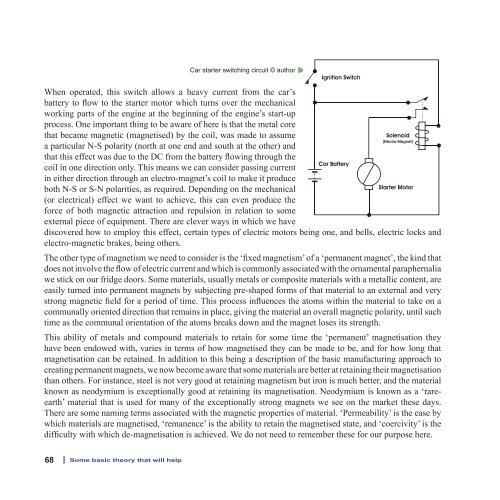A Beginner's View of Our Electric Universe - New
A Beginner's View of Our Electric Universe - New
A Beginner's View of Our Electric Universe - New
Create successful ePaper yourself
Turn your PDF publications into a flip-book with our unique Google optimized e-Paper software.
When operated, this switch allows a heavy current from the car’s<br />
battery to flow to the starter motor which turns over the mechanical<br />
working parts <strong>of</strong> the engine at the beginning <strong>of</strong> the engine’s start-up<br />
process. One important thing to be aware <strong>of</strong> here is that the metal core<br />
that became magnetic (magnetised) by the coil, was made to assume<br />
a particular N-S polarity (north at one end and south at the other) and<br />
that this effect was due to the DC from the battery flowing through the<br />
coil in one direction only. This means we can consider passing current<br />
in either direction through an electro-magnet’s coil to make it produce<br />
both N-S or S-N polarities, as required. Depending on the mechanical<br />
(or electrical) effect we want to achieve, this can even produce the<br />
force <strong>of</strong> both magnetic attraction and repulsion in relation to some<br />
external piece <strong>of</strong> equipment. There are clever ways in which we have<br />
discovered how to employ this effect, certain types <strong>of</strong> electric motors being one, and bells, electric locks and<br />
electro-magnetic brakes, being others.<br />
The other type <strong>of</strong> magnetism we need to consider is the ‘fixed magnetism’ <strong>of</strong> a ‘permanent magnet’, the kind that<br />
does not involve the flow <strong>of</strong> electric current and which is commonly associated with the ornamental paraphernalia<br />
we stick on our fridge doors. Some materials, usually metals or composite materials with a metallic content, are<br />
easily turned into permanent magnets by subjecting pre-shaped forms <strong>of</strong> that material to an external and very<br />
strong magnetic field for a period <strong>of</strong> time. This process influences the atoms within the material to take on a<br />
communally oriented direction that remains in place, giving the material an overall magnetic polarity, until such<br />
time as the communal orientation <strong>of</strong> the atoms breaks down and the magnet loses its strength.<br />
This ability <strong>of</strong> metals and compound materials to retain for some time the ‘permanent’ magnetisation they<br />
have been endowed with, varies in terms <strong>of</strong> how magnetised they can be made to be, and for how long that<br />
magnetisation can be retained. In addition to this being a description <strong>of</strong> the basic manufacturing approach to<br />
creating permanent magnets, we now become aware that some materials are better at retaining their magnetisation<br />
than others. For instance, steel is not very good at retaining magnetism but iron is much better, and the material<br />
known as neodymium is exceptionally good at retaining its magnetisation. Neodymium is known as a ‘rareearth’<br />
material that is used for many <strong>of</strong> the exceptionally strong magnets we see on the market these days.<br />
There are some naming terms associated with the magnetic properties <strong>of</strong> material. ‘Permeability’ is the ease by<br />
which materials are magnetised, ‘remanence’ is the ability to retain the magnetised state, and ‘coercivity’ is the<br />
difficulty with which de-magnetisation is achieved. We do not need to remember these for our purpose here.<br />
6 | Some basic theory that will help<br />
Car starter switching circuit © author<br />
Ignition Switch<br />
Car Battery<br />
Solenoid<br />
(Electro-Magnet)<br />
Starter Motor


